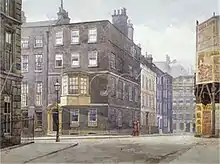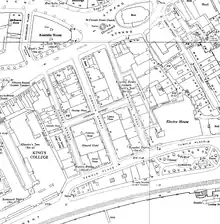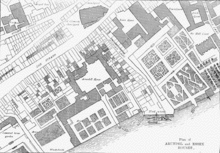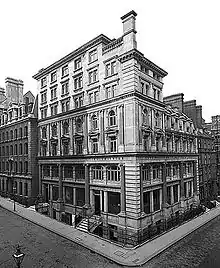Norfolk Street, Strand
Norfolk Street in the City of Westminster, London, ran from Strand in the north to the edge of the River Thames in the south, and after the Victoria Embankment was built (1865–1870), to what is now Temple Place. It was crossed only by Howard Street. It was demolished in the 1970s.

History


Norfolk Street was built on land once occupied by Arundel House and its gardens, the property of the Howard family, Dukes of Norfolk.[1] Norfolk Street and its neighbouring streets, Arundel, Howard, and Surrey, were all built after Arundel House was demolished by the earl of Arundel in 1678.[2]
The Norfolk Street tube station was planned for the street in 1902, but never built.
Norfolk Street and Howard Street were demolished in the 1970s in order to build Arundel Great Court[3] which was itself sold for redevelopment in 2012.[4][5]
Buildings
Amberley House, office of the Ecclesiastical Association, was at numbers 11 to 12 on the south-west corner with Norfolk Street.[3]
Hastings House at number 10 had literary connections, being home to the Women Writers' Club from 1894,[6] and the place from which the early literary agent A. P. Watt (1834–1914) practised.[7] The Middle Classes Defence Organization was also based in the building.[8]
Oswaldestre House

Oswaldestre House at 33–35 Norfolk Street was associated with engineering and radio technology. The name refers to the subsidiary title Baron Oswaldestre of the Dukes of Norfolk. The Engineer newspaper (est. 1856) was based there[9] and the building was also the registered address of a large number of consulting engineers, such as Henry Metcalfe Hobart. The Western Electric Company had an early radio station (2WP) on the third floor of the building in 1922.[10][11]
Former inhabitants
Former inhabitants of Norfolk Street include:[12]
- Percy Bysshe Shelley, poet, at Nos. 13 and 32 in 1816.
- Washington Irving, author, at No. 35 in 1805.
- Mary Mitford, bluestocking, at No. 35 in the 1830s.
- Samuel Taylor Coleridge, poet, at No. 42 in 1816.
- Alfred Tennyson, poet, in 1842.
- Peter the Great of Russia in 1698.
- William Penn, founder of Pennsylvania.
- Louisa Twining, philanthropist.[13]
References
- Bebbington, Gillian. (1972) London street names. London: B.T. Batsford. p. 27. ISBN 0713401400
- Richardson, John. (2000). The annals of London: A year-by-year record of a thousand years of history. Berkeley & Los Angeles: University of California Press. p. 155. ISBN 978-0-520-22795-8.
- Amberley House, 11–12 Norfolk Street, Westminster. Historic England. Retrieved 23 January 2017.
- Land Securities sells Arundel Great Court. Land Securities, 29 March 2012. Retrieved 25 January 2017.
- The Strand deserves to be treated with much more respect by King’s College. Simon Jenkins, Evening Standard, 5 May 2015. Retrieved 25 January 2017.
- Brake, Laurel & Marysa Demoor. (Eds.) (2009). Dictionary of nineteenth-century journalism in Great Britain and Ireland. Gent & London: Academia Press & The British Library. p. 686. ISBN 978-90-382-1340-8.CS1 maint: extra text: authors list (link)
- Gillies, Mary Ann. (2007). The professional literary agent in Britain, 1880–1920. Toronto: University of Toronto Press. p. 62. ISBN 978-0-8020-9147-5.
- "Altercation over civil society: The bitter cry of the Edwardian middle classes" by Philip Waller in Jose Harris (Ed.) (2005). Civil society in British history: Ideas, identities, institutions. Oxford: Oxford University Press. p. 132. ISBN 978-0-19-927910-4.CS1 maint: extra text: authors list (link)
- Oswaldestre House, 33–35 Norfolk Street, Westminster, Greater London. Historic England. Retrieved 23 January 2017.
- Briggs, Asa. (1961). The history of broadcasting in the United Kingdom: Volume I: The birth of broadcasting. Oxford: Oxford University Press. p. 81. ISBN 978-0-19-212926-0.
- Archive: When radio went live; Chris Upton looks back 80 years to the first radio broadcast in Birmingham. thefreelibrary.com Retrieved 25 January 2017.
- Williams, George G. Assisted by Marian and Geoffrey Williams. (1973) Guide to literary London. London: Batsford. pp. 85–86. ISBN 0713401419
- The Quiver, Annual Volume, 1903, page 463
External links
 Media related to Norfolk Street, Strand at Wikimedia Commons
Media related to Norfolk Street, Strand at Wikimedia Commons